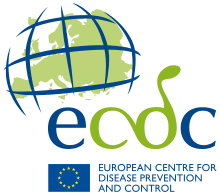European Centre for Disease Prevention and Control
 | |
| Centre overview | |
|---|---|
| Formed | 28 September 2004 |
| Jurisdiction | European Union |
| Headquarters |
Solna Municipality, Stockholm County, Sweden 59°22′22″N 18°1′2″E / 59.37278°N 18.01722°ECoordinates: 59°22′22″N 18°1′2″E / 59.37278°N 18.01722°E |
| Centre executive |
|
| Key document | |
| Website |
ecdc |
The European Centre for Disease Prevention and Control (ECDC) is an independent agency of the European Union (EU) whose mission is to strengthen Europe's defences against infectious diseases.[1] The Centre was established in 2004 and is located in Solna, Sweden.
History
As EU economic integration and open frontiers increased, cooperation on public health issues became more important. While the idea of creating a European centre for disease control had been discussed previously by public health experts, the 2003 SARS outbreak and the rapid spread of SARS across country borders confirmed the urgency of the creation of an EU-wide institution for public health. ECDC was set up in record time for an EU agency: the European Commission presented draft legislation in July 2003; by the spring of 2004, Regulation (EC) 851/2004 had been passed, and in May 2005 the Centre became operational. The relevance of the Centre's mission was confirmed shortly after it began operating, when the arrival of H5N1 avian influenza in the EU's neighbourhood led to fears that the disease could adapt or mutate into a pandemic strain of human influenza.
Organisational structure


The ECDC currently operates on a matrix structure based on five units:
- Office of the Chief Scientist
- Surveillance and Response Support
- Public Health Capacity and Communication
- Resource Management and Coordination
- Information and Communication Technologies
The office of the Chief Scientist oversees the seven Disease Programmes, the Microbiology Coordination Section and the Scientific Advice Coordination Section.
The Disease Programmes focus on specific disease groups:
- Antimicrobial Resistance and Healthcare-associated Infections
- Emerging and Vector-borne Diseases
- Food- and Waterborne Diseases and Zoonoses
- Sexually Transmitted Infections, including HIV and Blood-borne Viruses
- Influenza
- Tuberculosis
- Vaccine-preventable Diseases
Two shared-resource units – Surveillance and Response Support, and Public Health Capacity and Communication – provide specialist expertise. The Information and Communication Technologies Unit provides infrastructure, application development and support. The Resource Management and Coordination Unit controls ECDC’s human and financial resources.
Publications
ECDC publishes numerous scientific and technical reports covering various issues related to the prevention and control of communicable diseases. Comprehensive reports from key technical and scientific meetings are also produced by the organisation.
Towards the end of every calendar year, ECDC publishes its Annual Epidemiological Report, which analyses surveillance data and infectious disease threats. As well as offering an overview of the public health situation in the European Union, the report offers an indication of where further public health action may be required in order to reduce the burden caused by communicable diseases.
European Centre for Disease Prevention and Control is monitoring the Middle East respiratory syndrome coronavirus.[2]
Other ECDC publications include disease-specific surveillance reports and threat reports, as well as analyses of trends in European public health.
Eurosurveillance
Eurosurveillance, a European peer-reviewed journal devoted to the epidemiology, surveillance, prevention and control of infectious diseases, has been published by ECDC since March 2007. The journal was founded in 1995 and, before its move to ECDC, was a collaborative project between the European Commission, the Institut de Veille Sanitaire (France) and the Health Protection Agency (United Kingdom). Eurosurveillance is an open-access (i.e. free) web-based journal that reports infectious disease issues from a European perspective. It publishes results from ECDC and the EU-funded surveillance networks, thereby providing the scientific community with timely access to new information. The journal is published every Thursday.
Member states
In addition to the member states of the union, three members of the European Economic Area also participate in the ECDC network: Iceland, Liechtenstein and Norway.
Budget, staff, location
ECDC has a staff of around 300 and commands an annual budget of over €50 million. Staff operates from the Centre's headquarters in the Stockholm metropolitan area. The Centre moved to its current location at Gustav III:s Boulevard 40, 16973 Solna, Sweden, on 3 March 2018.
See also
For similar agencies, please see the List of national public health agencies
References
- Specific
- ↑ "ECDC mission statement". Archived from the original on 2009-11-04.
- ↑ "Rapid Risk Assessment: Severe respiratory disease associated with a novel coronavirus" (PDF). European Centre for Disease Prevention and Control. 19 February 2013.
External links
- Official website
- Eurosurveillance
- Eurovaccine at the Library of Congress Web Archives (archived 2009-11-26)
